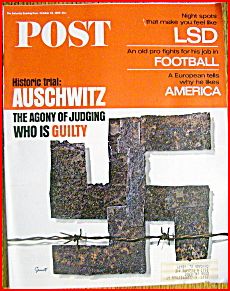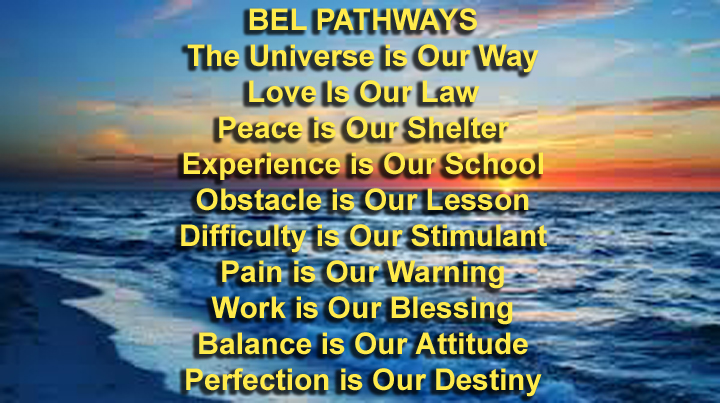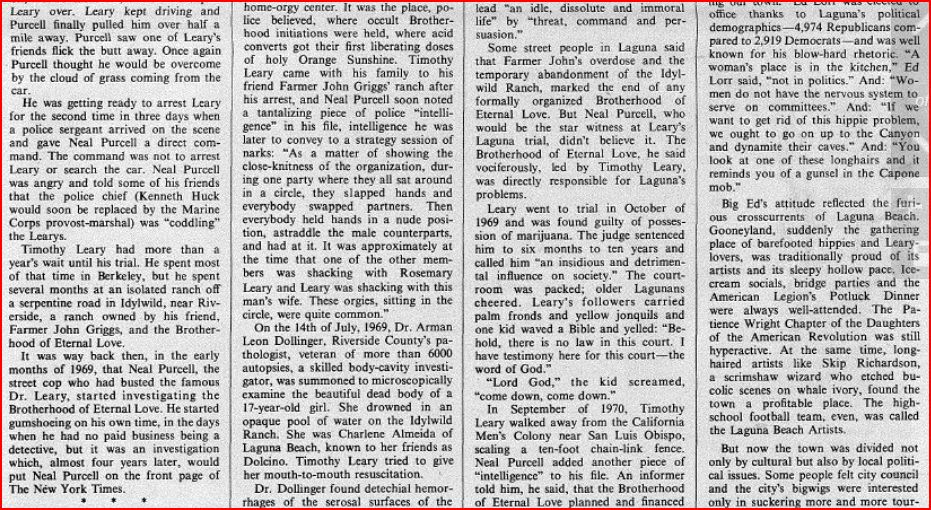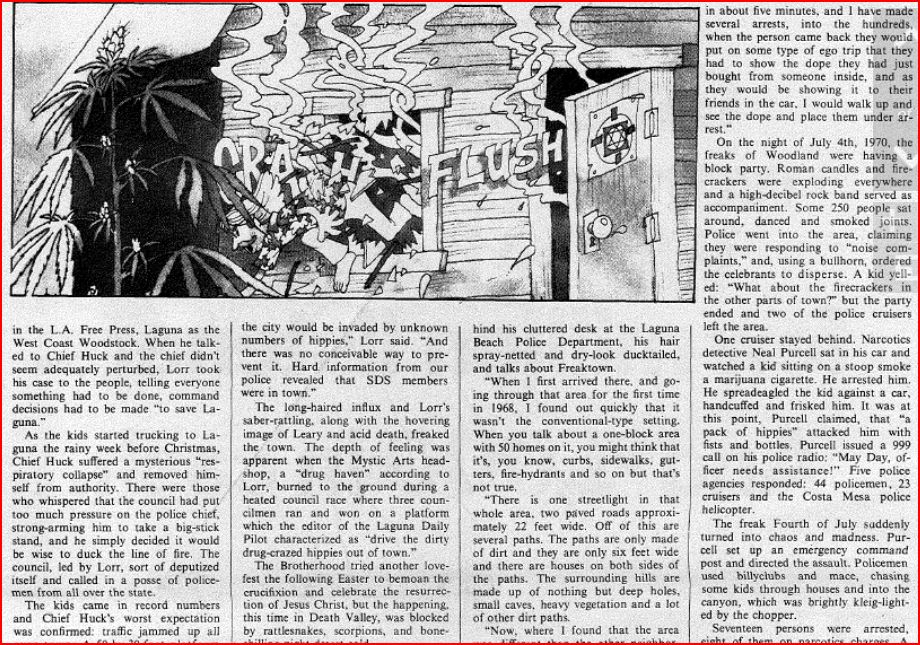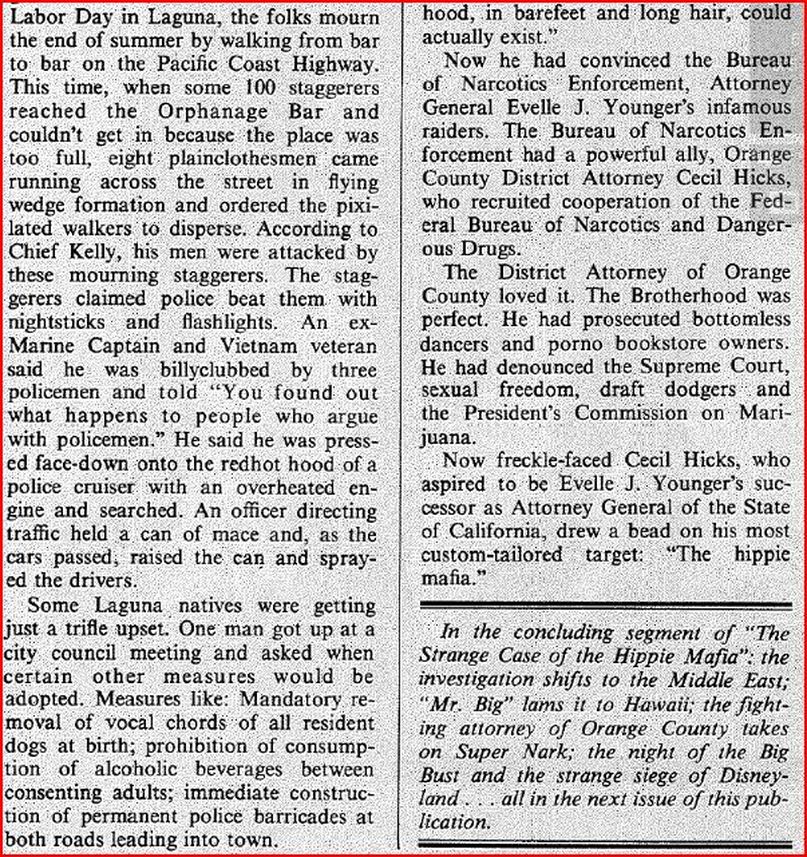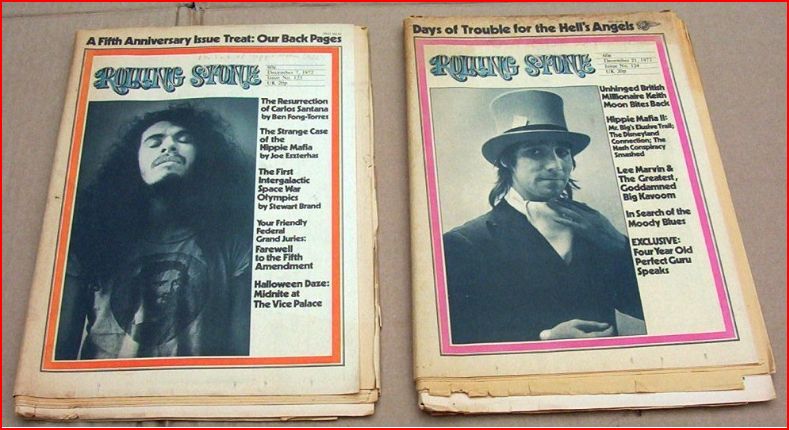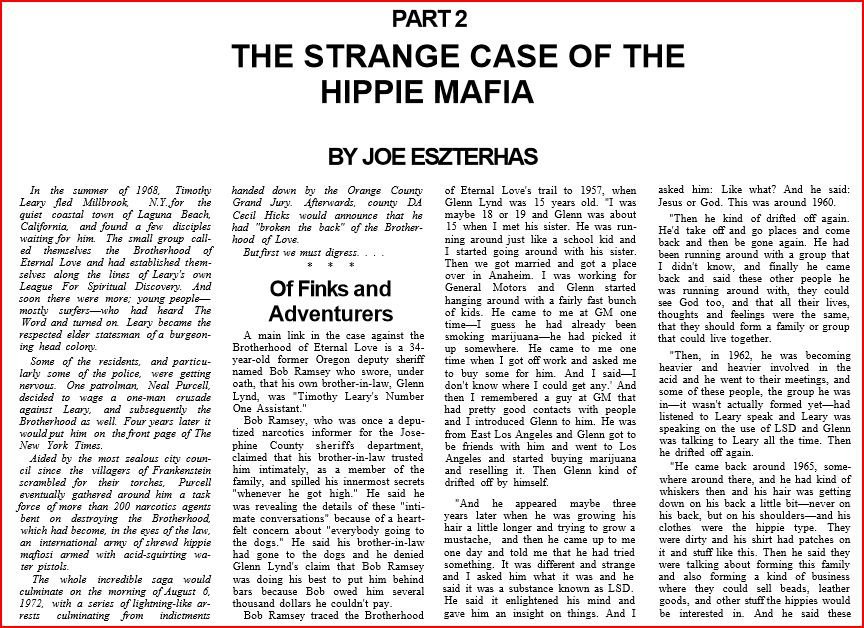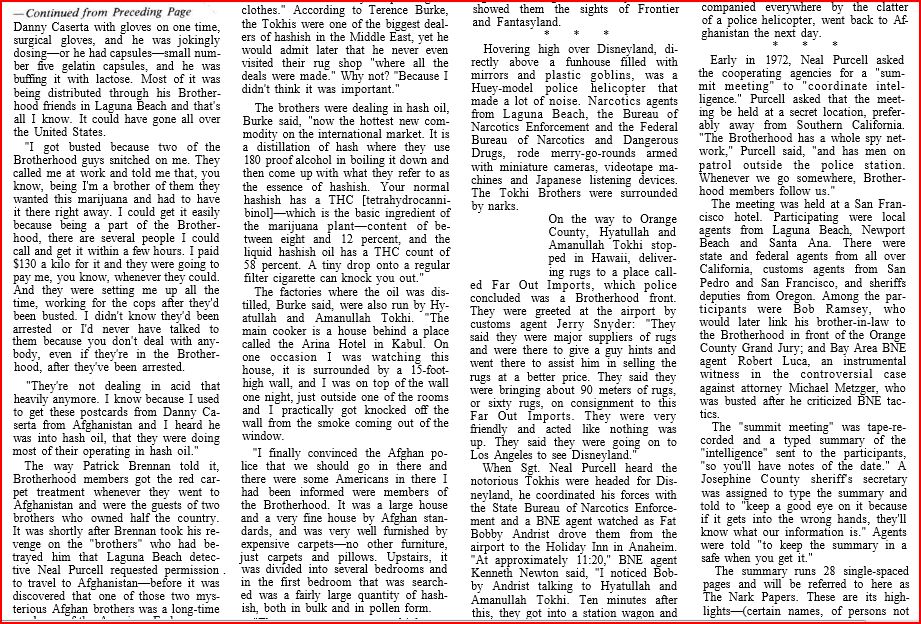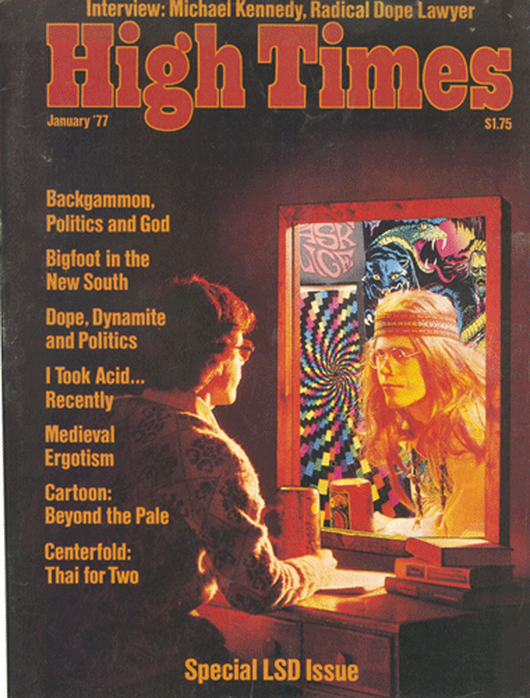MEDIA
Mis-, Dis-, & True Information
http://tightpantslover.deviantart.com/art/Brotherhood-of-Eternal-Love-49892599
Brotherhood of Eternal Love

The Brotherhood of Eternal Love
From Flower Power to Hippie Mafia:
The Story of the LSD Counterculture
by Stewart Tendler and David May
High Times Reader
http://books.google.com/books?id=vGxs0ad3x3IC&pg=PA40&dq=the+brotherhood+of+eternal+love&hl=en&ei=sY88Tv6VGtLWiAK9q5XDBg&sa=X&oi=book_result&ct=result&resnum=8&ved=0CEwQ6AEwBw#v=onepage&q&f=false
Contents
Dramatis Personae
Chronology
List of Illustrations
Foreword
Compound-25
Slow Dance of Golden Lights
Outlaw Days
The Badlands — Brotherhood International
The Brotherhood of Eternal Self-interest
Here Comes the Night
Epilogue
Bibliography
Acknowledgements
Panther Books Granada Publishing Ltd.
8 Grafton Street, London W1X 3LA
First published by Panther Books 1984
Copyright: Stewart Tendler and David May 1984
ISBN 0-586-04909-6
Ten days after California banned LSD in October 1966, Lynd, his wife and a friend walked into the offices of a Los Angeles attorney on Sunset Boulevard and signed the papers incorporating the Brotherhood; Lynd was the only Brother who did not have a criminal record, so he was designated to organize the incorporation. According to the legal papers, the Brotherhood, tax exempt, was dedicated 'to bring to the world a greater awareness of God through the teachings of Jesus Christ, Rama-Krishnam Babaji, Paramahansa Yogananda, Mahatma Gandhi and all true prophets and apostles of God'. Was there a hint of Leary's influence in this list? Griggs had recently returned from a trip to the East, and the Brothers were largely 'unschooled'.
To achieve its ends, the Brotherhood intended to 'buy, manage and own and hold real and personal property necessary and proper for a place of public worship and carry on educational and charitable work'. Was there an echo of the League's tenets in article 4-D which read: 'We believe in the sacred right of each individual to commune with God in spirit and in truth as it is empirically revealed to him'? This was 'a recognition that the search for God is a private matter', written another way.
Lynd said years later: 'Well, it was John Griggs' main idea to incorporate because he had talked to Leary, and it was possible to incorporate to become tax-exempt as far as land goes and, if and when marijuana ever becomes legal, become tax-exempt on marijuana.' There were no fixed rules for joining; no name signing or ritual. But there was one basic rule among the Brothers—they believed in taking as much of the psychedelics as possible, the largest doses of LSD they could buy. The articles of association did not explain how the Brotherhood intended to buy its land or establish its place of worship. You cannot really tell a lawyer or the State of California that you intend to raise capital by breaking the law—by massive dealing in drugs.
From Flower Power to Hippie Mafia:
The Story of the LSD Counterculture
by Stewart Tendler and David May
High Times Reader
http://books.google.com/books?id=vGxs0ad3x3IC&pg=PA40&dq=the+brotherhood+of+eternal+love&hl=en&ei=sY88Tv6VGtLWiAK9q5XDBg&sa=X&oi=book_result&ct=result&resnum=8&ved=0CEwQ6AEwBw#v=onepage&q&f=false
Contents
Dramatis Personae
Chronology
List of Illustrations
Foreword
Compound-25
Slow Dance of Golden Lights
Outlaw Days
The Badlands — Brotherhood International
The Brotherhood of Eternal Self-interest
Here Comes the Night
Epilogue
Bibliography
Acknowledgements
Panther Books Granada Publishing Ltd.
8 Grafton Street, London W1X 3LA
First published by Panther Books 1984
Copyright: Stewart Tendler and David May 1984
ISBN 0-586-04909-6
Ten days after California banned LSD in October 1966, Lynd, his wife and a friend walked into the offices of a Los Angeles attorney on Sunset Boulevard and signed the papers incorporating the Brotherhood; Lynd was the only Brother who did not have a criminal record, so he was designated to organize the incorporation. According to the legal papers, the Brotherhood, tax exempt, was dedicated 'to bring to the world a greater awareness of God through the teachings of Jesus Christ, Rama-Krishnam Babaji, Paramahansa Yogananda, Mahatma Gandhi and all true prophets and apostles of God'. Was there a hint of Leary's influence in this list? Griggs had recently returned from a trip to the East, and the Brothers were largely 'unschooled'.
To achieve its ends, the Brotherhood intended to 'buy, manage and own and hold real and personal property necessary and proper for a place of public worship and carry on educational and charitable work'. Was there an echo of the League's tenets in article 4-D which read: 'We believe in the sacred right of each individual to commune with God in spirit and in truth as it is empirically revealed to him'? This was 'a recognition that the search for God is a private matter', written another way.
Lynd said years later: 'Well, it was John Griggs' main idea to incorporate because he had talked to Leary, and it was possible to incorporate to become tax-exempt as far as land goes and, if and when marijuana ever becomes legal, become tax-exempt on marijuana.' There were no fixed rules for joining; no name signing or ritual. But there was one basic rule among the Brothers—they believed in taking as much of the psychedelics as possible, the largest doses of LSD they could buy. The articles of association did not explain how the Brotherhood intended to buy its land or establish its place of worship. You cannot really tell a lawyer or the State of California that you intend to raise capital by breaking the law—by massive dealing in drugs.
Heilig, S., "The Brotherhood of Eternal Love-From Flower Power to Hippie Mafia: The Story of LSD Counterculture", Journal of Psychoactive Drugs, 2007, Vol 39; No 3, pages 307-308
High Times
Rolling Stone
The Hippie Mafia", Rolling Stone #123 and #124.
http://www.scribd.com/doc/94439371/Eszterhas-The-Strange-Case-of-the-Hippie-Mafia-Pt-1-1972
http://www.scribd.com/doc/94439371/Eszterhas-The-Strange-Case-of-the-Hippie-Mafia-Pt-1-1972
|
Cover / Feature Article: Carlos Santana
Other Features: Strange Case of the Hippie Mafia, First Intergalactic Space Olympics, Monkees Man Does a Fillmore of the Air. Articles: Allman's Berry Oakley Killed, Jefferson Airplane Tries Shock Rock, Ashford & Simpson, Why Bill Graham Lunged at Herb Resner, Jackson Five on Their Own. Record Reviews: Miles Davis, Santana, Black Sabbath, Harry Chapin, Mott The Hoople, Jesse Winchester, Ry Cooder, Chicago, Blood Sweat and Tears, Sonny Rollins, Jackson Five, Michael Jackson, Jermain Jackson, Persuasions, Bee Gees. |
Cover / Feature Article: Keith Moon - The Who
Other Features: Lee Marvin, Famous Motorcycle Gang, The Moody Blues, The Hippie Mafia, Interview with 4 year old perfect Master. Articles: Blood Sweat and Tears, Mickie Most, Gato Barbieri, Little Eva. Record Reviews: Pete Townshend of the Who, John Entwistle of the Who, Carole King, Captain Beefheart & the Magic Band, Barbra Streisand, Bette Midler, Sandy Denny, Poco, The Four Tops, Mom's Apple Pie, Luther Ingram. |
Part 1 & 2 - http://www.scribd.com/doc/95924904/Eszterhas-The-Strange-Case-of-the-Hippie-Mafia-Finereader-Ocr
http://www.scribd.com/doc/8344935/TendlerMay-The-Brotherhood-of-Eternal-Love-Social-History-of-LSD
http://www.scribd.com/doc/8344935/TendlerMay-The-Brotherhood-of-Eternal-Love-Social-History-of-LSD
Art by Terry Lamb - http://www.terrylambart.com/
Alleged Drug Czar Returned to O.C.
July 03, 1990|DAN WEIKEL | Los Angeles TIMES STAFF WRITER
http://articles.latimes.com/1990-07-03/news/mn-790_1_drug-smuggling/2
He and his lawyers contend that the charges are greatly exaggerated and that a search of Rancho del Rio in 1985 might have been improper, which could force the suppression of key evidence against him.
Fowlie has spent much of the last three years at Centro de Readaptacion Social and, with the help of an errand boy and friends in Cabo San Lucas, managed to make a living selling art and doing consulting work for a construction business.
The Times reported in March that during his imprisonment, Fowlie's captors freed him repeatedly to go marlin fishing, visit his beachfront house and work on a shopping center in Cabo San Lucas, a popular haven for American sportsmen.
Sources said Fowlie was often given four-day passes from prison to pursue recreation and personal business in Cabo San Lucas, where he is known to dozens of hoteliers, restaurateurs, lawyers and skippers of sportfishing boats.
His oil paintings of fish and marine fowl also have been shown at art shows in the town, and the bar association of Baja California, Sur, commissioned him to do a painting of a horned owl for President Salinas. Fowlie has photos of the presentation to the president.
Fowlie's return ends almost 20 years of investigations that have led federal, state and local authorities from Orange County to Central America and Europe in pursuit of him.
Authorities first suspected Fowlie of being involved in drugs in the late 1960s and early 1970s when police said they linked him to the infamous Brotherhood of Eternal Love in Laguna Beach.
The loose-knit organization of about 200 people was founded by Timothy Leary, a Harvard University psychology instructor who espoused the "mind-expanding" properties of hashish, marijuana and the hallucinogen, LSD.
Fowlie, a former abalone diver and surfer who formed a pioneering contingent of big wave riders in Hawaii during the early 1950s, owned the Leather Gypsy in Laguna Beach at the time. The successful leather goods manufacturer had plants in Mexico and major accounts with such retail mainstays as Sears and J.C. Penney.
Laguna Beach Police Chief Neil Purcell, who investigated the Brotherhood as a detective, said Fowlie was suspected of being part of the organization's drug distribution network, which was broken up with the arrests of 46 members in 1972.
Fowlie, who lived in South Laguna, was never arrested. He said he sold the Leather Gypsy in the early 1970s for about $3 million during a recession in the fashion industry and left the United States.
Eventually he said he went to Costa Rica, where he bought farmland, beachfront property that includes a popular surfing spot and a mansion from fugitive financier Robert L. Vesco.
Vesco remains accused of stealing $392 million from mutual fund investors and secretly giving $200,000 to former President Richard M. Nixon's 1972 reelection campaign in an attempt to obstruct a Securities and Exchange Commission investigation. He is believed to live in Cuba.
Fowlie's name resurfaced in connection with drug smuggling in 1979 when an informant told state narcotics agents that large shipments were arriving at the ranch. State law enforcement officials indicate that Fowlie was capable of handling 400 pounds of cocaine a month.
J.D. Miles, agent-in-charge of the state Bureau of Narcotics Enforcement office in Orange County, said that as late as 1984, state agents were developing information on Rancho del Rio and Fowlie's holdings in Costa Rica and Panama. No charges resulted, however.
"People kept coming forward to give us tips. But none of them wanted to come forward as a witness, and a lot of their information was old," Miles said. "We were pretty much stymied because our target was in Holland, Costa Rica and Mexico, completely out of our realm."
The FBI, IRS and Customs Service took over the investigation and raided Rancho del Rio in February, 1985, after Orange County sheriff's deputies arrested a ranch employee at a house in South Laguna.
Two years later, Fowlie was arrested by Mexican authorities in Puerto Escondido, south of Acapulco, and mounted a lengthy extradition fight from prison. Meanwhile, six people associated with him, including his two sons, have been convicted on drug smuggling charges.
Of Fowlie's return to the United States, Orange County Sheriff Brad Gates said: "I think this shows that no matter where dope dealers go and try to hide we're going to find them. . . . I think the FBI, the DEA and the INS deserve a lot of credit."
RANCHO DEL RIO CHRONOLOGY
July 03, 1990|DAN WEIKEL | Los Angeles TIMES STAFF WRITER
http://articles.latimes.com/1990-07-03/news/mn-790_1_drug-smuggling/2
He and his lawyers contend that the charges are greatly exaggerated and that a search of Rancho del Rio in 1985 might have been improper, which could force the suppression of key evidence against him.
Fowlie has spent much of the last three years at Centro de Readaptacion Social and, with the help of an errand boy and friends in Cabo San Lucas, managed to make a living selling art and doing consulting work for a construction business.
The Times reported in March that during his imprisonment, Fowlie's captors freed him repeatedly to go marlin fishing, visit his beachfront house and work on a shopping center in Cabo San Lucas, a popular haven for American sportsmen.
Sources said Fowlie was often given four-day passes from prison to pursue recreation and personal business in Cabo San Lucas, where he is known to dozens of hoteliers, restaurateurs, lawyers and skippers of sportfishing boats.
His oil paintings of fish and marine fowl also have been shown at art shows in the town, and the bar association of Baja California, Sur, commissioned him to do a painting of a horned owl for President Salinas. Fowlie has photos of the presentation to the president.
Fowlie's return ends almost 20 years of investigations that have led federal, state and local authorities from Orange County to Central America and Europe in pursuit of him.
Authorities first suspected Fowlie of being involved in drugs in the late 1960s and early 1970s when police said they linked him to the infamous Brotherhood of Eternal Love in Laguna Beach.
The loose-knit organization of about 200 people was founded by Timothy Leary, a Harvard University psychology instructor who espoused the "mind-expanding" properties of hashish, marijuana and the hallucinogen, LSD.
Fowlie, a former abalone diver and surfer who formed a pioneering contingent of big wave riders in Hawaii during the early 1950s, owned the Leather Gypsy in Laguna Beach at the time. The successful leather goods manufacturer had plants in Mexico and major accounts with such retail mainstays as Sears and J.C. Penney.
Laguna Beach Police Chief Neil Purcell, who investigated the Brotherhood as a detective, said Fowlie was suspected of being part of the organization's drug distribution network, which was broken up with the arrests of 46 members in 1972.
Fowlie, who lived in South Laguna, was never arrested. He said he sold the Leather Gypsy in the early 1970s for about $3 million during a recession in the fashion industry and left the United States.
Eventually he said he went to Costa Rica, where he bought farmland, beachfront property that includes a popular surfing spot and a mansion from fugitive financier Robert L. Vesco.
Vesco remains accused of stealing $392 million from mutual fund investors and secretly giving $200,000 to former President Richard M. Nixon's 1972 reelection campaign in an attempt to obstruct a Securities and Exchange Commission investigation. He is believed to live in Cuba.
Fowlie's name resurfaced in connection with drug smuggling in 1979 when an informant told state narcotics agents that large shipments were arriving at the ranch. State law enforcement officials indicate that Fowlie was capable of handling 400 pounds of cocaine a month.
J.D. Miles, agent-in-charge of the state Bureau of Narcotics Enforcement office in Orange County, said that as late as 1984, state agents were developing information on Rancho del Rio and Fowlie's holdings in Costa Rica and Panama. No charges resulted, however.
"People kept coming forward to give us tips. But none of them wanted to come forward as a witness, and a lot of their information was old," Miles said. "We were pretty much stymied because our target was in Holland, Costa Rica and Mexico, completely out of our realm."
The FBI, IRS and Customs Service took over the investigation and raided Rancho del Rio in February, 1985, after Orange County sheriff's deputies arrested a ranch employee at a house in South Laguna.
Two years later, Fowlie was arrested by Mexican authorities in Puerto Escondido, south of Acapulco, and mounted a lengthy extradition fight from prison. Meanwhile, six people associated with him, including his two sons, have been convicted on drug smuggling charges.
Of Fowlie's return to the United States, Orange County Sheriff Brad Gates said: "I think this shows that no matter where dope dealers go and try to hide we're going to find them. . . . I think the FBI, the DEA and the INS deserve a lot of credit."
RANCHO DEL RIO CHRONOLOGY
Tendler, Stewart & May, David. The Brotherhood of Eternal Love: From Flower Power to Hippie Mafia: The Story of LSD Counterculture.(Book review).
It's hard to fathom at this late date, but once upon a time there were a significant number of intelligent people who believed that the world would be a much better place if everybody ingested psychedelic drugs and that such drugs should be provided free, or at least without profit. And one of the few semi-organized loci of such thought was a mysterious cohort of Californians known as the Brotherhood of Eternal Love.
Who or what was this Brotherhood? According to famed "dope lawyer" Michael Kennedy, who defended some of them when they got into trouble, "It was a loose-knit group of individuals, the common denominator being that they all believed in psychedelics, they all believed in hallucinogenics and they all believed that the world would be better if more people took psychedelics. And what they tried to do was spread as many psychedelic substances as they could around the land. Sort of like Johnny Appleseed" (Rosenbaum 1994).
This book was originally published in 1984, but was then quickly withdrawn from print, thus becoming an expensive collector's item. In this new version, the authors provide a new forward and epilogue but do not mention any reason for the previous disappearance, leaving that among the numerous mysterious elements to this story. Whoever authorized the garish dayglo-type cover art should remainr mysterious as well, but otherwise, it's a fascinating read about a now long-ago wild yet relatively innocent and idealistic time when the inner and external horizons of culture seemed open to virtually any interpretation and stretching.
The story of LSD has been told in great and skilled detail in at least two books since the original publication of this one (Stevens 1998; Lee & Shlain 1985). From Hoffman's inadvertent discovery of LSD to Huxley's explorations through Leary and Alpert's Harvard experiments and debacles to the explosion of 1960s counterculture and acid rock and so forth, the tale is well-documented, and has been analyzed and romanticized ad nauseam. So why is this book worth reading, at least for those still interested?
Well, the Brotherhood were a unique element of their time, at a minimum. Legally incorporated in 1966--ten days after LSD became illegal--in California, the tax-exempt organization declared a dedication "to bring to the world a greater awareness of God through the teachings of Jesus Christ, Rama-Krishnam Babaji, Paramahansa Yogananda, Mahatma Gandhi and all true prophets and apostles of God." Some of their nascent ideology was reflective of Timothy Leary's east coast League of Spiritual Discovery, but the BOEL were headquartered in Laguna Beach, California, "a sleepy little township and artists colony and resort thirty miles south of Los Angeles." As for membership, "there were no fixed rules for joining; no name signing or ritual. But there was one basic rule among the Brothers--they believed in taking as much of the psychedelics as possible, the largest doses of LSD they could buy."
In the beginning it was a relatively benign scene, as reported by one early Brother who was part of the early group living in few houses in idyllic Laguna Canyon: "There was a lot of grass and there was a vibe that you could make it with love and digging each other. It was cheap and it was fun. You know the bond, the thing that tied us up together was surfing and dope and balling." The focus went from grass to LSD and large quantities of hash rather quickly, it seems, and before long, a "hippie mafia" (as it was labeled by local law authorities and then Rolling Stone magazine) was in effect. But before then, for just just a couple years, the Brotherhood were at the center of "a Haight-Ashbury on the sea."
During that brief period of dreams and relative innocence, Orange Sunshine LSD was tossed out freely at concerts and on the beach. "John Gale, a rising figure in the Brotherhood's distribution network, was spreading the word for the Brothers' new LSD in the best way he knew how: on Laguna Beach he handed out 100,000 doses in a day." The group was associated with a cool surf shop and the famed Mystic Arts World, a crafts market/open air illegal pharmacy (this reviewer recalls walking through Mystic Arts at the age of 13 or so and being offered LSD, hash, and other drugs I'd never heard of; I also recall a health food store with a real camel living out back).
The Brotherhood's products/sacraments did not stay free for long. As this book puts it, "the group's task may have been divine, but the fruits were certainly worldly." Linked with (in)famous Grateful Dead-associated LSD (al)chemist Owsley Stanley up in San Francisco, and with Leary on the east coast, the Brotherhood's operations got grandiose and risky. Cash was everywhere, ranches were bought, surfboards full of hash were made and mailed around the world, an infamously incoherent Jimi Hendrix film was financed, and at one point a tentative offer was tendered to the government of France to buy a tiny Pacific French island to become "the world's first independent state based on LSD." Timothy Leary's son, at a Laguna Brotherhood gathering, torched one of many $1000 bills, and when Leary called to apologise for his offspring's behavior, he was told "Hey, Uncle Tim, we all wanted to burn a thousand-dollar bill. It was a great thing he did, very enlightening."
Legal authorities were not so enlightened or amused. In Laguna Beach--which sits in Republican stronghold Orange County, just up the coast from Nixon's West Coast White House--longhairs started to get busted for just being there, and suspicions were aroused by the presence of money and Leary. Still, the Brotherhood funded Leary's famous escape from California prison and supported him with an extra $25,000 while he was the exiled guest/hostage of Eldridge Cleaver in Algeria. State, Federal and and international investigations got underway as well. Mystic Arts World burnt to the ground in a 1970 fire widely viewed as arson that was approved, if not committed, by local authorities. By the time a couple of founding leaders has overdosed or been arrested (including Leary, who turned out to be more liability than leader) trouble was everywhere for the Brothers. A big bust became pretty much inevitable, and in 1972 it came. "Between 1966 and 1971 the Brotherhood was virtually untouchable, but in the course of the investigation 750 members had been identified in a business the IRS estimated to be worth $200 million." Such estimates tend to be inflated, but no matter, the BOEL corporation was assessed over $70 million in back taxes (the book does not say whether any of that assessment was ever paid). Members rolled over and turned one another in to avoid doing time. A government report estimated that the Brotherhood was held responsible for 50% of all the LSD and hash to be found in the United States.
By then much of the illegal activity had shifted to Europe, as personified by a mysterious figure named Ronald Stark, who flitted around the world under various false identities (multiple fake passports were a Brotherhood specialty). Here the story gets a bit more mundane, even though it involves more clandestine laboratories and international intrigue. The founding and early Brothers died--in such manners as decapitation in a Porsche--did prison time, or just drifted away, and the harder-edged types who stayed in the business for the big money took over, for awhile at least. "Only the players had changed--not the game."
Tendler and May find a few surviving figures in this updated version of their book, all of them older and some wiser (they also quote from a lengthy newspaper article that does not appear in their updated bibliography; Schou 2005). "As flawed as it is, having a civilization seems much better than anarchy; this is one of the reasons why I wonder if we made a mistake in scattering acid to the four winds" reflects one key figure. Another key figure "saw himself and the Brotherhood as part of a great tradition of semi-secret societies driven by a powerful doctrine and stretching back to the original Sufis, early Islamic mystics, and the Knights Templar. In the case of the Brotherhood their divine sacrament was LSD. Like other outcasts before them, they had accepted calumny, vilification, and persecution for their beliefs."
Perhaps. The persecution may not have been quite so intense if so much illegal money had not become central to the faith. But in any event, this is a fascinating story. A filmed documentary is forthcoming, and maybe another book, and certainly verbal lore about the Brotherhood will continue for some time, or at least as long as the Summer of Love generational mythology remains commercially viable. Tendler and May are wise enough to admit they might not have all the facts down pat. "Establishing a single truth in such an epic narrative of idealism and betrayal, wealth and corruption as the Brotherhood of Eternal Love, a story where so many people's lives depended on the truth not being told, is probably an impossible ambition."
In renowned writer Robert Stone's new memoir Prime Green: Remembering the Sixties, he recalls his experiences with Ken Kesey's iconic Merry Pranksters, who were sort of a precursor to the Brotherhood. "The drugs which we believed so important a part of our liberation, the key to the music, the doors of perception for an elite, became a mass youth phenomenon," he observes. "They caused much suffering and parental anguish, and they forged a weapon for the darkest forces in American society, the witch-hunting, punitive-minded hypocrites who promptly gave us the War on Drugs as they had given us Prohibition ... We may not have had any choice, but in the end we allowed drugs to be turned into a weapon against everything we believed in."
Thus, as went the dreamers in the original Brotherhood, so went a generation and a nation.
REFERENCES
Lee, M.A. & Shlain, B. 1985. Acid Dreams: The Complete Social History of LSD: The CIA, the Sixties, and Beyond. New York: Grove Press.
Rosenbaum, R. 1994. Michael Kennedy: An interview. In: A. Nocenti, & R. Baldwin (Eds.) The High Times Reader. New York: Nation Books.
Schou, N. 2005: Lords of Acid: How the Brotherhood of Eternal Love became OC's Hippie Mafia. OC Weekly July 7.
Stevens, J. 1998. Storming Heaven: LSD and the American Dream. New York: Grove Press.
Stone, R. 2007. Prime Green: Remembering the Sixties. New York: Ecco.
Reviewed by Steve Heilig, M.P.H.*
It's hard to fathom at this late date, but once upon a time there were a significant number of intelligent people who believed that the world would be a much better place if everybody ingested psychedelic drugs and that such drugs should be provided free, or at least without profit. And one of the few semi-organized loci of such thought was a mysterious cohort of Californians known as the Brotherhood of Eternal Love.
Who or what was this Brotherhood? According to famed "dope lawyer" Michael Kennedy, who defended some of them when they got into trouble, "It was a loose-knit group of individuals, the common denominator being that they all believed in psychedelics, they all believed in hallucinogenics and they all believed that the world would be better if more people took psychedelics. And what they tried to do was spread as many psychedelic substances as they could around the land. Sort of like Johnny Appleseed" (Rosenbaum 1994).
This book was originally published in 1984, but was then quickly withdrawn from print, thus becoming an expensive collector's item. In this new version, the authors provide a new forward and epilogue but do not mention any reason for the previous disappearance, leaving that among the numerous mysterious elements to this story. Whoever authorized the garish dayglo-type cover art should remainr mysterious as well, but otherwise, it's a fascinating read about a now long-ago wild yet relatively innocent and idealistic time when the inner and external horizons of culture seemed open to virtually any interpretation and stretching.
The story of LSD has been told in great and skilled detail in at least two books since the original publication of this one (Stevens 1998; Lee & Shlain 1985). From Hoffman's inadvertent discovery of LSD to Huxley's explorations through Leary and Alpert's Harvard experiments and debacles to the explosion of 1960s counterculture and acid rock and so forth, the tale is well-documented, and has been analyzed and romanticized ad nauseam. So why is this book worth reading, at least for those still interested?
Well, the Brotherhood were a unique element of their time, at a minimum. Legally incorporated in 1966--ten days after LSD became illegal--in California, the tax-exempt organization declared a dedication "to bring to the world a greater awareness of God through the teachings of Jesus Christ, Rama-Krishnam Babaji, Paramahansa Yogananda, Mahatma Gandhi and all true prophets and apostles of God." Some of their nascent ideology was reflective of Timothy Leary's east coast League of Spiritual Discovery, but the BOEL were headquartered in Laguna Beach, California, "a sleepy little township and artists colony and resort thirty miles south of Los Angeles." As for membership, "there were no fixed rules for joining; no name signing or ritual. But there was one basic rule among the Brothers--they believed in taking as much of the psychedelics as possible, the largest doses of LSD they could buy."
In the beginning it was a relatively benign scene, as reported by one early Brother who was part of the early group living in few houses in idyllic Laguna Canyon: "There was a lot of grass and there was a vibe that you could make it with love and digging each other. It was cheap and it was fun. You know the bond, the thing that tied us up together was surfing and dope and balling." The focus went from grass to LSD and large quantities of hash rather quickly, it seems, and before long, a "hippie mafia" (as it was labeled by local law authorities and then Rolling Stone magazine) was in effect. But before then, for just just a couple years, the Brotherhood were at the center of "a Haight-Ashbury on the sea."
During that brief period of dreams and relative innocence, Orange Sunshine LSD was tossed out freely at concerts and on the beach. "John Gale, a rising figure in the Brotherhood's distribution network, was spreading the word for the Brothers' new LSD in the best way he knew how: on Laguna Beach he handed out 100,000 doses in a day." The group was associated with a cool surf shop and the famed Mystic Arts World, a crafts market/open air illegal pharmacy (this reviewer recalls walking through Mystic Arts at the age of 13 or so and being offered LSD, hash, and other drugs I'd never heard of; I also recall a health food store with a real camel living out back).
The Brotherhood's products/sacraments did not stay free for long. As this book puts it, "the group's task may have been divine, but the fruits were certainly worldly." Linked with (in)famous Grateful Dead-associated LSD (al)chemist Owsley Stanley up in San Francisco, and with Leary on the east coast, the Brotherhood's operations got grandiose and risky. Cash was everywhere, ranches were bought, surfboards full of hash were made and mailed around the world, an infamously incoherent Jimi Hendrix film was financed, and at one point a tentative offer was tendered to the government of France to buy a tiny Pacific French island to become "the world's first independent state based on LSD." Timothy Leary's son, at a Laguna Brotherhood gathering, torched one of many $1000 bills, and when Leary called to apologise for his offspring's behavior, he was told "Hey, Uncle Tim, we all wanted to burn a thousand-dollar bill. It was a great thing he did, very enlightening."
Legal authorities were not so enlightened or amused. In Laguna Beach--which sits in Republican stronghold Orange County, just up the coast from Nixon's West Coast White House--longhairs started to get busted for just being there, and suspicions were aroused by the presence of money and Leary. Still, the Brotherhood funded Leary's famous escape from California prison and supported him with an extra $25,000 while he was the exiled guest/hostage of Eldridge Cleaver in Algeria. State, Federal and and international investigations got underway as well. Mystic Arts World burnt to the ground in a 1970 fire widely viewed as arson that was approved, if not committed, by local authorities. By the time a couple of founding leaders has overdosed or been arrested (including Leary, who turned out to be more liability than leader) trouble was everywhere for the Brothers. A big bust became pretty much inevitable, and in 1972 it came. "Between 1966 and 1971 the Brotherhood was virtually untouchable, but in the course of the investigation 750 members had been identified in a business the IRS estimated to be worth $200 million." Such estimates tend to be inflated, but no matter, the BOEL corporation was assessed over $70 million in back taxes (the book does not say whether any of that assessment was ever paid). Members rolled over and turned one another in to avoid doing time. A government report estimated that the Brotherhood was held responsible for 50% of all the LSD and hash to be found in the United States.
By then much of the illegal activity had shifted to Europe, as personified by a mysterious figure named Ronald Stark, who flitted around the world under various false identities (multiple fake passports were a Brotherhood specialty). Here the story gets a bit more mundane, even though it involves more clandestine laboratories and international intrigue. The founding and early Brothers died--in such manners as decapitation in a Porsche--did prison time, or just drifted away, and the harder-edged types who stayed in the business for the big money took over, for awhile at least. "Only the players had changed--not the game."
Tendler and May find a few surviving figures in this updated version of their book, all of them older and some wiser (they also quote from a lengthy newspaper article that does not appear in their updated bibliography; Schou 2005). "As flawed as it is, having a civilization seems much better than anarchy; this is one of the reasons why I wonder if we made a mistake in scattering acid to the four winds" reflects one key figure. Another key figure "saw himself and the Brotherhood as part of a great tradition of semi-secret societies driven by a powerful doctrine and stretching back to the original Sufis, early Islamic mystics, and the Knights Templar. In the case of the Brotherhood their divine sacrament was LSD. Like other outcasts before them, they had accepted calumny, vilification, and persecution for their beliefs."
Perhaps. The persecution may not have been quite so intense if so much illegal money had not become central to the faith. But in any event, this is a fascinating story. A filmed documentary is forthcoming, and maybe another book, and certainly verbal lore about the Brotherhood will continue for some time, or at least as long as the Summer of Love generational mythology remains commercially viable. Tendler and May are wise enough to admit they might not have all the facts down pat. "Establishing a single truth in such an epic narrative of idealism and betrayal, wealth and corruption as the Brotherhood of Eternal Love, a story where so many people's lives depended on the truth not being told, is probably an impossible ambition."
In renowned writer Robert Stone's new memoir Prime Green: Remembering the Sixties, he recalls his experiences with Ken Kesey's iconic Merry Pranksters, who were sort of a precursor to the Brotherhood. "The drugs which we believed so important a part of our liberation, the key to the music, the doors of perception for an elite, became a mass youth phenomenon," he observes. "They caused much suffering and parental anguish, and they forged a weapon for the darkest forces in American society, the witch-hunting, punitive-minded hypocrites who promptly gave us the War on Drugs as they had given us Prohibition ... We may not have had any choice, but in the end we allowed drugs to be turned into a weapon against everything we believed in."
Thus, as went the dreamers in the original Brotherhood, so went a generation and a nation.
REFERENCES
Lee, M.A. & Shlain, B. 1985. Acid Dreams: The Complete Social History of LSD: The CIA, the Sixties, and Beyond. New York: Grove Press.
Rosenbaum, R. 1994. Michael Kennedy: An interview. In: A. Nocenti, & R. Baldwin (Eds.) The High Times Reader. New York: Nation Books.
Schou, N. 2005: Lords of Acid: How the Brotherhood of Eternal Love became OC's Hippie Mafia. OC Weekly July 7.
Stevens, J. 1998. Storming Heaven: LSD and the American Dream. New York: Grove Press.
Stone, R. 2007. Prime Green: Remembering the Sixties. New York: Ecco.
Reviewed by Steve Heilig, M.P.H.*
http://channel.nationalgeographic.com/channel/locked-up-abroad/episodes/hunting-mr-nice/
It was San Francisco, in the late 60's and early 70's, when music, drugs, and brotherly love flowed freely. Three young renegades -- an older brother, a second born, and an older friend -- link up. These young seekers embrace brotherhood at a time when 30 million Americans are testing the same waters. Making money, turning on, tuning in, and damning the system run strong at their core. Mexico is the land of plenty for marijuana and the renegades seize on this opportunity, bringing contraband over the border hidden in the floorboards of their contact's truck. With experience and success the operation grows, until they have their own planes, pilots and landing strip. But along the way disaster strikes -- again and again. The brothers must contend with the law, their spurious adversaries who attempt to derail them, and driving emotional forces that control and guide their fragile psyches toward self-destruction. A final and gripping catastrophe lands them in a Mexican jail. Faced with a long jail sentence the author has one saving grace: the love of a young woman who came into his life shortly before his ruin. Through her he is inspired to gain back lost freedoms and to draw strength from the priceless wisdom gained during the four-year journey. But the story doesn't end there . . . Survival depends, once again, on overcoming immense odds. He and his fellow captives must band together and embrace brotherhood as never before. "American Brothers" is a memoir that captures an enduring slice of Americana and reads like an action-packed novel...
To Live Outside the Law

http://www.leaffielding.com/
To Live Outside the Law published by Serpent's Tail on July 7, 2011 OPERATION JULIE, BRITAIN'S BIGGEST DRUGS BUST, had only ever been told from the official point of view. Until now…
The narrative moves back and forth between the harsh, dangerous world of prison and the events that led him there – starting from a childhood blighted by personal tragedy and a brutal boarding school, onto undergraduate days and his LSD epiphany in the summer of ’67. Acid transformed him in an instant from nerdy scholar to footloose freak. His ten years of ridiculous and extraordinary adventures in the hippie underground gave the title to this book – they took him from Reading, Berkshire across Europe, to Indochina, to the Andes and on to the edge of the known universe. They also led inexorably to his downfall.
The book doesn’t seek to make excuses – or indeed to apologise – instead it aims to explain and entertain. The title is from a Bob Dylan song – the full quotation is ‘To live outside the law you must be honest’ and honesty is at the heart of this extraordinary work.
To Live Outside the Law published by Serpent's Tail on July 7, 2011 OPERATION JULIE, BRITAIN'S BIGGEST DRUGS BUST, had only ever been told from the official point of view. Until now…
- On a cold March morning in 1977, in coordinated raids on eighty seven houses, over eight hundred police officers arrested more than a hundred people and brought to an end a huge LSD manufacturing and distribution ring.
- To Live Outside the Law is the first, and only, insider account of this conspiracy. But the book is much more than just that, it is also a compelling personal story, one which offers remarkable insights into a time, a mindset, a generation and a major chapter in British criminal history... and it’s an absolutely thrilling read.
The narrative moves back and forth between the harsh, dangerous world of prison and the events that led him there – starting from a childhood blighted by personal tragedy and a brutal boarding school, onto undergraduate days and his LSD epiphany in the summer of ’67. Acid transformed him in an instant from nerdy scholar to footloose freak. His ten years of ridiculous and extraordinary adventures in the hippie underground gave the title to this book – they took him from Reading, Berkshire across Europe, to Indochina, to the Andes and on to the edge of the known universe. They also led inexorably to his downfall.
The book doesn’t seek to make excuses – or indeed to apologise – instead it aims to explain and entertain. The title is from a Bob Dylan song – the full quotation is ‘To live outside the law you must be honest’ and honesty is at the heart of this extraordinary work.
Fair Use copyrights apply; Educational Purposes Only
(c)2013, Aquarian Temple BEL, BrotherhoodofEternal Love.org
"Official" History Site
Peace * Love * Groovy
Fair Use Notice
This site contains copyrighted material the use of which has not always been specifically authorized by the copyright owner. We are making such material available in our efforts to advance understanding of environmental, political, human rights, economic, democracy, scientific, and social justice issues, etc. We believe this constitutes a 'fair use' of any such copyrighted material as provided for in section 107 of the US Copyright Law. In accordance with Title 17 U.S.C. Section 107, the material on this site is distributed without profit to those who have expressed a prior interest in receiving the included information for research and educational purposes. If you wish to use copyrighted material from this site for purposes of your own that go beyond 'fair use', you must obtain permission from the copyright owner.
(c)2013, Aquarian Temple BEL, BrotherhoodofEternal Love.org
"Official" History Site
Peace * Love * Groovy
Fair Use Notice
This site contains copyrighted material the use of which has not always been specifically authorized by the copyright owner. We are making such material available in our efforts to advance understanding of environmental, political, human rights, economic, democracy, scientific, and social justice issues, etc. We believe this constitutes a 'fair use' of any such copyrighted material as provided for in section 107 of the US Copyright Law. In accordance with Title 17 U.S.C. Section 107, the material on this site is distributed without profit to those who have expressed a prior interest in receiving the included information for research and educational purposes. If you wish to use copyrighted material from this site for purposes of your own that go beyond 'fair use', you must obtain permission from the copyright owner.






